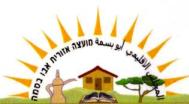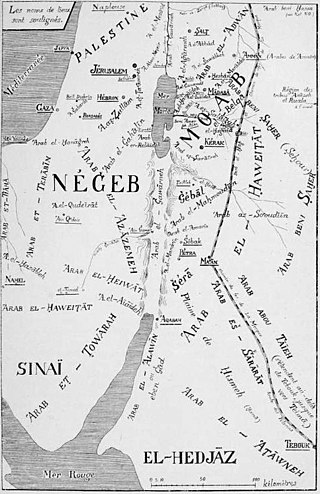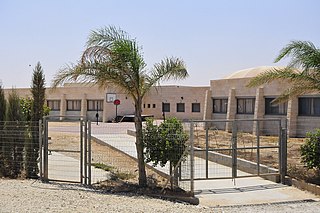
Blueprint Negev is a Jewish National Fund (JNF) project to construct new Jewish communities in the Negev region of Israel and boost Jewish settlement in the region.

Blueprint Negev is a Jewish National Fund (JNF) project to construct new Jewish communities in the Negev region of Israel and boost Jewish settlement in the region.
The last large-scale development project to accommodate and promote new Jewish immigration was during the 1980s, when "Operation Promised Land" was launched to accommodate massive upsurge of Jewish immigration from the Soviet Union and Ethiopia.
In May 2006, Shimon Peres said that his first task as Minister of Development of the Negev and Galilee would be to promote the construction of a new Jewish community in the Negev, Karmit, the first to be built under the Blueprint Negev plan after Be'er Milka. [1] Ynet reported that the community was "designated for wealthy, young American immigrants who want to make aliyah and live in style." [2] Former JNF President Ronald Lauder said that Blueprint Negev answers the need for Jews looking to make aliyah the pioneering way. [3]
The plan aims to bring 250,000 new residents to the Negev over ten years. Toward that goal, the project has sought to direct Anglo (English-speaking) immigration to the Negev and has compiled a database (currently containing some 10,000 names) of current Israeli citizens interested in relocating to the Negev. After the Disengagement together with the Or Negev settlement movement, [4] the JNF was instrumental in helping Gaza evacuees find new homes in the Negev as cohesive units. [5] [6]
The plan aims to increase the population of Beersheba, the Negev's largest city. One of the main projects undertaken there is the Be’er Sheva River Walk, creating a 900-acre (3.6 km2) park inspired by San Antonio’s River Walk. [7] The plan includes green spaces, an amphitheater for events, a lake for boating and promenades for strolling. The JNF supported cleanup of the riverbed.
The plan envisions the creation of 25 new suburban communities. [3] Seven communities that have already been established are Sansana (1999) 54 families, Tzukim (2001) 72 families, Merchav Am (2002) 34 families, Giv’ot Bar/Shomria (2004) 30 families, Haruv (2005) 30 families, Be'er Milka/Kmehin (2006) 12 families, Karmit, and Kasif. [8] Sansana is part of the Har Hebron Regional Council governing Hebron-area settlements.
Israeli and Jewish American environmental groups have expressed concern that creation of isolated suburban communities in the Negev will lead to water and energy intensive suburban sprawl [9] and strain Bedouin-Jewish relations. [4] They argue that the planned developments will require a large public investment per capita that benefits a small number of comparatively well-off immigrants in a region with high poverty rates. [10] Daniel Orenstein claims the project is not the answer to overdevelopment in the north. [11] Blueprint Negev has been accused of discriminating against Bedouins and endangering their way of life. [12]
In 2012, the OECD presented a paper for promoting development in the Negev, "Clean-Tech Clustering as an Engine for Local Development: The Negev Region." It cited the Negev's "niche in research, demonstration and testing in renewable energies and water efficiency," and described the region's 50 clean-tech businesses, 4 technological incubators and clean-tech research capacity as a "serious comparative advantage." [13]

The Negev or Negeb is a desert and semidesert region of southern Israel. The region's largest city and administrative capital is Beersheba, in the north. At its southern end is the Gulf of Aqaba and the resort city and port of Eilat. It contains several development towns, including Dimona, Arad and Mitzpe Ramon, as well as a number of small Bedouin towns, including Rahat and Tel Sheva and Lakiya. There are also several kibbutzim, including Revivim and Sde Boker; the latter became the home of Israel's first Prime Minister, David Ben-Gurion, after his retirement from politics.

The Jewish Agency for Israel, formerly known as the Jewish Agency for Palestine, is the largest Jewish non-profit organization in the world. It was established in 1929 as the operative branch of the World Zionist Organization (WZO).

Beersheba, officially Be'er-Sheva, is the largest city in the Negev desert of southern Israel. Often referred to as the "Capital of the Negev", it is the centre of the fourth-most populous metropolitan area in Israel, the eighth-most populous Israeli city with a population of 211,251, and the second-largest city in the area, with a total area of 117,500 dunams.

Jewish National Fund is a non-profit organization founded in 1901 to buy and develop land in Ottoman Syria for Jewish settlement. By 2007, it owned 13% of the total land in Israel. Since its inception, the JNF says it has planted over 240 million trees in Israel. It has also built 180 dams and reservoirs, developed 250,000 acres (1,000 km2) of land and established more than 1,000 parks.

Meitar is a small local council north-east of Beersheba, in Israel's Southern District. The town lies on Highway 60 just south of the Green Line on the southern edge of Mount Hebron, alongside the Yatir Forest. Metar is 19 km north of Beer-Sheva and is in between the two Bedouin towns of Hura and Laqiya. In 2021 it had a population of 10,565.

Ramat HaNegev Regional Council is a regional council in the Negev desert in Israel. With around 8,000 residents spread across 20 villages, the council is geographically the largest in Israel, covering more than 20% of Israel's landmass. The council's headquarters are located on Highway 40 between Mashabei Sadeh and Tlalim.

Abu Basma Regional Council was a regional council operating in 2003-2012 and covering several Bedouin villages in the northwestern Negev desert of Israel. Following the Minister of Interior decision on November 5, 2012 it was split into two newly created bodies: Neve Midbar Regional Council and al-Kasom Regional Council.

Bir Hadaj is a Bedouin agricultural town located in the Negev desert, near Revivim, Israel. In 2021 its population was 6,167.

The Negev Bedouin are traditionally pastoral nomadic Arab tribes (Bedouin), who until the later part of the 19th century would wander between Saudi Arabia in the east and the Sinai Peninsula in the west. Today they live in the Negev region of Israel. The Bedouin tribes adhere to Islam.

Be'er Tuvia is a moshav in the Southern District of Israel. Located near the city of Kiryat Malakhi, it falls under the jurisdiction of Be'er Tuvia Regional Council. In 2021 its population was 1,294.
Israeli Jews or Jewish Israelis are Israeli citizens and nationals who are Jewish through either their Jewish ethnicity and/or their adherence to Judaism. The term also includes the descendants of Jewish Israelis who have emigrated and settled outside of the State of Israel, where they are predominantly found in the Western world. The overwhelming majority of Israeli Jews speak Hebrew, a Semitic language, as their native tongue.

Qasr al-Sir is a Bedouin village in the Negev desert in southern Israel, adjacent to highway 25. The village covers 4,776 dunams. Located three kilometres west of Dimona, it falls under the jurisdiction of Neve Midbar Regional Council. In 2021 it had a population of 2,731.

Tirabin al-Sana, also Tarabin, is a Bedouin village in the Negev desert in southern Israel. The village was built for the Tarabin tribe. Located near Rahat and Mishmar HaNegev, it falls under the jurisdiction of al-Kasom Regional Council. In 2021 it had a population of 1,240.

Unrecognized Bedouin villages in Israel are rural Bedouin communities in the Negev and the Galilee which the Israeli government does not recognize as legal. They are often referred to as "unrecognized villages".
Carmit Hebrew: כרמית is a community settlement in the northern Negev of Israel within the jurisdiction of Meitar located near Cramim Forest.

Reuven "Ruvik" Danilovich is an Israeli politician. In 2008, he was elected mayor of Be'er Sheva, after serving as deputy mayor under Yaakov Turner.


The Tirabin, were the most important Arab tribe in the Sinai Peninsula during the 19th century, and the largest inside Negev. Today this tribe resides in the Sinai Peninsula but also in Cairo, Ismailia, Giza, Al Sharqia and Suez, Israel (Negev), Jordan, Saudi Arabia and the Gaza strip. A township named Tirabin al-Sana was built in Israel in 2004 especially for the members of al-Sana clan from Al-Tirabin tribe.
Neve Midbar Regional Council is one of two regional councils formed as a result of a split of Abu Basma Regional Council on November 5, 2012. This regional council is situated in the northwestern Negev desert of Israel and populated by the Negev Bedouin.

al-Kasom Regional Council is one of two Negev Bedouin regional councils formed as a result of the split of the Abu Basma Regional Council on November 5, 2012. Al-Kasom regional council is in the northwestern Negev desert of Israel.